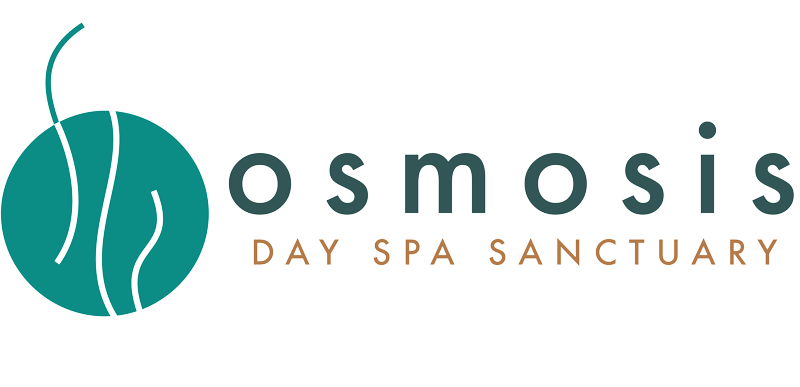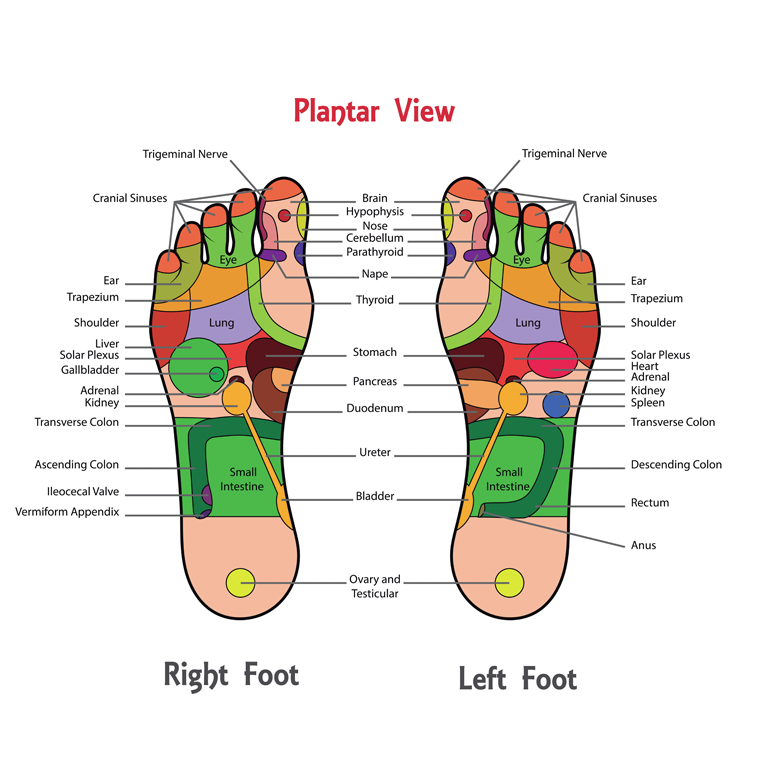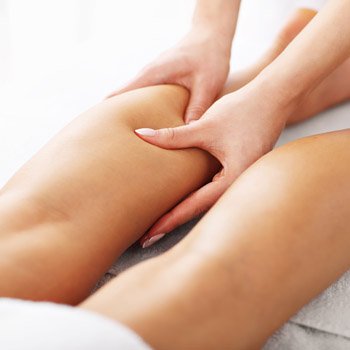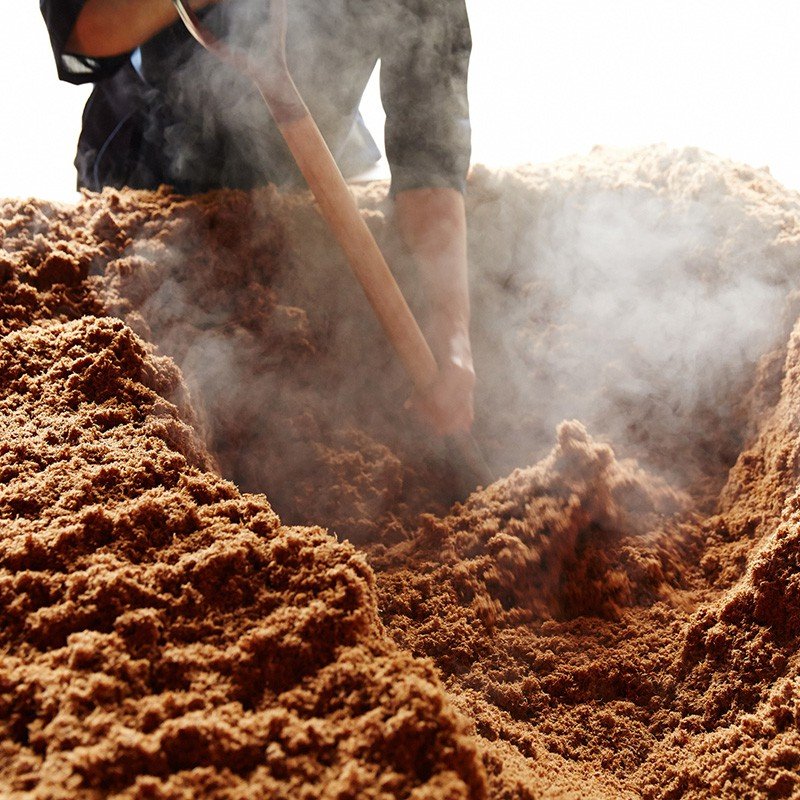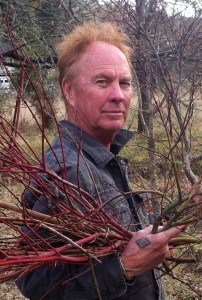Foot Reflexology: Not Just a Foot Massage
Many people believe that a Foot Reflexology session is just a relaxing foot massage. While Foot Reflexology is indeed relaxing, it has many other benefits.
The foot contains ten reflex zones, each corresponding to a different body area. Specific reflex points also correspond to internal organs, glands, and sense organs. For example, the center of the pad of the big toe has a reflex point for the pituitary gland. The ball of the left big toe has a reflex point for the heart, and the ball of the pinky toe has a reflex zone for the shoulder. There are over 50 reflex points on the feet. When these points are stimulated with specific massage techniques, the body’s natural healing abilities activate. Pain reduces, organ function improves, and some diseases may even resolve. While massage therapists who perform Foot Reflexology are not medical practitioners and cannot diagnose or treat, decades of practice show the healing potential of this modality.
How does Reflexology work?
Foot Reflexology works on several levels.
Research from the 1890s by Henry Head and Charles Sherrington shows the neurological relationship between the skin and internal organs. They found that the nervous system adjusts to stimuli. When pressure is applied to the feet, the calming message is carried through peripheral nerves to the central nervous system, signaling the body to relax. This enhanced relaxation increases blood supply to the internal organs and their systems. Additionally, this relaxation helps the body move naturally toward homeostasis and more optimal functioning.
The neuromatrix theory of pain helps us understand how Reflexology reduces pain levels. According to this theory, pain is a subjective experience created by the brain. The brain responds not only to physical stimuli but also to emotional and cognitive factors. Thus, your moods and stress levels can affect your experience of pain. Reflexology may reduce pain by lowering stress and improving mood.
Reflexology is recognized as a specific type of massage developed based on Zone Theory. Dr. William Fitzgerald developed Zone Theory in the early 1900s. It divides the body into 10 vertical zones, each corresponding to fingers and toes up to the head. In Reflexology, every organ, gland, or body part within a zone can be accessed via a reflex zone or point on the foot or hand. For example, working on the horizontal reflex zone at the base of the ball of the foot affects the solar plexus and diaphragm. These pathways between reflex zones and other parts of the body are thought to be connected via the nervous system.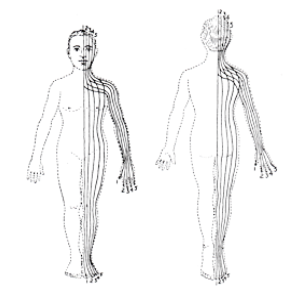
History
Modern reflexology is based on an ancient form of therapy. Evidence shows that foot and hand therapy was practiced in Tibet and China as long ago as 4,000 B.C. It was also practiced in Egypt at the same time, as depicted in the tomb of Ankhmahor. The North American tribes of Indians are known to have practiced foot therapy for hundreds of years. While the true origin of this powerful therapy is unclear, it has stood the test of time and has helped thousands of people achieve better health.
Zone Therapy
Dr. William FitzGerald (1872-1942) is credited with being the father of zone therapy. He worked in Vienna starting around 1899. Zone therapy divides the body into ten zones—five on each side of the sagittal plane. The hands/arms and feet/legs were also divided into five zones each. In the book “Zone Therapy,” co-authored by Dr. Edwin Bowers and Dr. FitzGerald in 1917, they write that FitzGerald discovered zone therapy in 1909. However, they do not indicate where he became acquainted with the theory. From 1915 into the early thirties, zone therapy was controversial but met with some success with doctors and dentists as a form of pain relief.
Reflex Work
Dr. Joe Shelby Riley (1856-1947), trained by Dr. FitzGerald, further developed zone therapy by adding eight horizontal divisions to the zones of the feet and hands. His work marks the beginning of reflexology as it is known today, identifying reflexes on the feet and hands that follow the anatomy of the body. Riley’s work with reflexes and zones also included the hands and ears.
Reflexology
In the 1930s, Eunice D. Ingham (1889-1972) met Riley and worked for him in St. Petersburg, Florida. She continued to refine and improve his work. Encouraged by Riley and others, she published her first book, “Stories the Feet Can Tell” (1938), and took her work to the public and non-medical community. Eunice’s major contribution was that alternating pressure, rather than having a numbing effect, stimulated healing. For forty years, she lectured and traveled across the United States, and is largely responsible for Foot Reflexology as taught today in most massage schools.
Reflexology at Osmosis Day Spa Sanctuary
At Osmosis, we recognize that Foot Reflexology can enhance the healing potential of any massage experience. We offer a 15-minute Reflexology Enhancement that can be booked with any massage modality of any length. This enhancement not only feels good and promotes deep relaxation, but it also increases blood supply to internal organs, promoting healing and reducing pain. Click here to book a massage with a Reflexology Enhancement.
___________________________________________
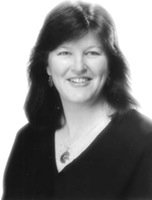 Raizelah Bayen is a California Certified Massage Therapist, currently employed as the Director of Training and Massage Therapist Supervisor at Osmosis Day Spa Sanctuary in Freestone, California. She has been practicing massage for over 25 years, and teaching T’ui Na, Acupressure, Sports and Pregnancy Massage in massage certification programs for 15 years. Raizelah is an approved CEU Instructor by the National Certification Board of Therapeutic Massage and Bodywork (NCBTMB), offering trainings in Freestone, California and on-site training at your massage school or spa. For more information, connect with Raizelah Bayen on LinkedIn.
Raizelah Bayen is a California Certified Massage Therapist, currently employed as the Director of Training and Massage Therapist Supervisor at Osmosis Day Spa Sanctuary in Freestone, California. She has been practicing massage for over 25 years, and teaching T’ui Na, Acupressure, Sports and Pregnancy Massage in massage certification programs for 15 years. Raizelah is an approved CEU Instructor by the National Certification Board of Therapeutic Massage and Bodywork (NCBTMB), offering trainings in Freestone, California and on-site training at your massage school or spa. For more information, connect with Raizelah Bayen on LinkedIn.
Please contact raizelah@osmosis.com for information on upcoming trainings in T’ui Na, Shiatsu, Thai Massage, Foot Reflexology, and Body Mechanics for Bodyworkers scheduled in Sebastopol, California. Or book Raizelah for an on-site training in your massage school or spa in T’ui Na, Shiatsu, Thai Massage, Foot Reflexology or Body Mechanics for Bodyworkers.
